Did the Corman-Drosten Protocol “rely on social media reports” to seek (& then find) SARS-CoV-2?
Last edits/additions made 25 September 2025
Amidst so many problems with the Corman-Drosten protocol — the PCR testing assay used to launch a pandemic — and the circumstances around its emergence, it’s easy to miss a curious and troubling statement in the results section:
Before public release of virus sequences from cases of 2019-nCoV, we relied on social media reports announcing detection of a SARS-like virus. We thus assumed that a SARS-related CoV is involved in the outbreak.
This was a bizarre and striking thing to say, especially given that virus said to be responsible for “SARS” was found both in people with SARS and many people who had no symptoms at all, and people can have severe acute respiratory syndromes and not test positive for any virus, or for multiple ones (if tested for).
So why was this assumption made? A group of scientists was saying they made an assumption about a virus involved in an alleged outbreak based on social media reports about its detection. Which "social media reporting" was it? Why did the test developers rely on it? Is this "science" — or "social media science"?
Corman et al went on to say that, based on the rumors, they went straight to GenBank and downloaded SARS-related sequences.
We downloaded all complete and partial (if > 400 nt) SARS-related virus sequences available in GenBank by 1 January 2020. The list (n = 729 entries) was manually checked and artificial sequences (laboratory-derived, synthetic, etc), as well as sequence duplicates were removed, resulting in a final list of 375 sequences.
So not only did 24 scientists from six different countries endorse social media posts as a credible source, they apparently used those as the basis for searching a database, to the exclusion of other possibilities. No citation for these reports is given, nor is there any indication of how these reports were discovered or accessed, by whom, or why they were considered authentic, important, or confirmatory.
Adding insult to injury, the peer reviewers and editors of Eurosurveillance, the scientific journal which published the protocol and describes itself as “among the top journals in its field” allowed the authors to say they relied on social media reporting without citing or explaining the reports.
This seems an extraordinary laxity considering that both journal editors and any article reviewers would have — or should have — understood the crucial importance of considering the possibility that prior assumptions might influence the direction and outcome of this scientific endeavour.
Corresponding author Christian Drosten did not respond to an inquiry sent several months ago, so we are left to surmise about possible candidates for these “social media” posts.1
Potential Candidates
Tweets
Two news stories imply or state that the reports were tweets. A 20 January 2020 Berliner Zeitung article pointed to “what could be read on Twitter shortly before the new year” as the catalyst for Drosten and his Charite colleagues’ revelation that a SARS-like virus could be the culprit of the alleged outbreak in Wuhan.
Five months later, The Independent pointed to the platform more explicitly, saying, “The German virologist Christian Drosten – who in 2003 developed the first diagnostic test for Sars – heard about the outbreak the next day, from a member of his lab who had caught wind of it on Twitter."
One possibility is a 30 December 2019 tweet from an account called “Panda”, started in August 2019, and ostensibly from Hong Kong, that posted images of health alerts from Wuhan with screenshots of chats mentioning SARS.
ProMed
Another candidate is mentioned in the book, Meine Pandemie Professor Drosten Laborbedingungen. Author Walter Van Rossum suggests “social media reports” in the Corman-Drosten paper refers to posts on the ProMed-mail forum, an infectious disease specialist hangout.2 The content duplicates news stories published on Sina Finance and makes mention of SARS.3
Flu Trackers
Posts on FluTrackers.com dated 30 and 31 December 2019 shared similar reports. One highlighted a tweet and said (translated), “I don’t know who this is, but this person is tweeting that SARS has been confirmed”.
The account (HongbaoChen) is locked, but the contents which were allegedly reproduced say, “I heard that the 7 critical cases diagnosed were SARS, Wuhan Tongji Hospital, and Huada Gene. Coronavirus has also been confirmed in the Houhu District of Wuhan Second Hospital.” However, the HongbaoChen account appears to have been created in November 2023, which raises questions about the authenticity of the tweet and of the FluTracker posts.
EDIT 9 September 2025:
made us aware that the HongBaoChen Twitter account shown above is not the original HongBaoChen account that posted the tweet in question. The original account appears to have been deleted and a new account was created in November 2023 with the same handle. An image of the original account replying to Peter Daszak on 31 December 2019, archived here, is shown below.Avian Flu Diary
Avian Flu Diary reported the local announcements and mentioned the SARS rumors on FluTrackers.
Authentic or Planted?
We hesitate to pore over what the social media reports we’ve shown are saying — or to put any stock in the notion of Drosten and his cohorts actually being directed to a SARS database by tweets, internal message boards, etc — because verifiable evidence of an outbreak in Wuhan involving a new pathogen that subsequently turned into a global pandemic is scant. We do wonder, however, if social media chatter about SARS could have been planted as part of the ‘spreading novel virus’ storyline.
A February 2020 paper released by Chinese scientists purported to show spikes in the use of SARS, coronavirus, and shortness of breath on WeChat weeks before ‘cases’ were identified. The graph showing use of ‘SARS’ and Feidian (the Chinese name for SARS) certainly looks meaningful.
Irrespective of authenticity, and whatever Drosten’s role in the covid event, perhaps he and/or his colleagues were sent or exposed to conversations on that platform in December 2019 or sooner?
A Fast Test for the West
The Corman-Drosten protocol was developed and released at remarkable speed. Just two weeks elapsed between the Wuhan Municipal Health Commission issuing health alerts on December 30, 2019, and the WHO’s initial publication on January 13, 2020. Recently, the WHO appeared to acknowledge its proactive role in the test’s development, stating that it had “brought together partners to publish the blueprint of the first SARS-CoV-2 laboratory test.” How these “partners” were assembled and who (or WHO) initiated contact remains unknown.
Five years later, the identity of social media reports attributed in Corman et al’s Eurosurveillance paper is also unknown, as is the reason a group of well-credentialed scientists mentioned such reports in an academic article without being compelled to provide links to the reports or defend their decision to rely on those sources.
We’ve reviewed possible candidates not to place undue attention on “The Mystery of the Missing Social Media” but to further highlight how slipshod the science involved in the development and publications of the test protocol really was.
It would be remiss of us to not proffer the hypothesis that this mention of “social media” was deliberately misdirective. Could the function of this unverified — and unverifiable — claim have been to muddy the waters as regards the precise sequence of events, and create plausible deniability for having been aware of, and partaking in, an artificial and constructed timeline?
Many other questions about the development of the test still remain unanswered or (worse) unasked. What Christian Drosten and his co-developers knew, when they knew it, and how they knew it are among the most important.
Appendices (post-publication additions)
Repeat Performance
Added 20 Feb 2025
Christian Drosten was also central to the speedy development of the PCR test for SARS-1. The process also reportedly began “online,” with Drosten and his team reading daily Internet postings about a mysterious respiratory illness in Vietnam.
Corman or Drosten: Who heard first?
Added 5 September 2025
Three news reports state or suggest that Victor Corman heard about SARS being involved in an alleged outbreak in Wuhan before Christian Drosten did.
Berliner Zeitung: “What could be read on Twitter shortly before the turn of the year reminded the virus experts at the Charité of an old acquaintance. In Wuhan, a metropolis of eleven million in central China, a novel viral disease had apparently broken out. There was no official confirmation or detailed information about the type of virus. Only rumors on social media. But the team around Christian Drosten, director of the Institute of Virology, sudded that this could be a Sars-like virus. And he and his team are experts for Sars-like viruses.”
Science: “When another severe respiratory syndrome emerged this year, Drosten—who moved to the prestigious Charité University Hospital in 2017—was prepared. After seeing the first rumors about a coronavirus in China online, Victor Corman, who leads the lab's virus diagnostics group, began to search existing sequences of SARS-related coronaviruses, isolated from bats, for regions that were the same across different viruses. He was trying to guess what parts of a new SARS-like coronavirus might look like, in order to create a test. Based on those sequences, he designed and ordered 20 pairs of so-called primers, little snippets of DNA, that pair with a pathogen's genome, so that it can be amplified and detected.”
Independent: “The German virologist Christian Drosten – who in 2003 developed the first diagnostic test for Sars – heard about the outbreak the next day, from a member of his lab who had caught wind of it on Twitter."
Earlier Notice?
Added 5 August 2025
In a video program released on 27 March 2020, Marion Koopmans — professor of virology at Erasmus MC and co-author of the Corman-Drosten protocol — said she first heard about the Wuhan outbreak “through social media and a newspaper,” calling the start “as unusual as everything that followed.”
Koopmans didn’t say when she heard, but in the same program, Erasmus colleague Ron Fouchier (who is not on the Corman et al paper) said he and unspecified others became aware in early December [2019], roughly four weeks sooner than the WHO.
Transcript excerpt below4:
Narrator: [Ron] Fouchier and [Marion] Koopmans were the first to hear about the outbreak in China. They heard alarm bells while most people thought it was a local problem.
Interviewer: Where were you when you first heard about the crisis in China?
Ron Fouchier: We hear these things early on, so it was the first week of December. We were told about an outbreak of an unknown disease in Wuhan.
Marion Koopmans: The start was as unusual as everything that followed: I heard it through social media and a newspaper.
RF: The first few weeks of rumors were identical to the ones in 2003 with the SARS outbreak.
In another video program airing 22 March 2020, Fouchier said he heard in early December (“just after Sinterklass,” which is 5/6 December). However, in Sept 2021, The Daily Mail reported,
Prof Fouchier told this newspaper he had been muddled over his dates since their discussions were in late December. 'I am sorry about this confusion,' he said.
It’s hard to believe that Fouchier was ‘muddled’ in March 2020 about a relatively recent memory — and one closely associated with a holiday.
Ron Fouchier was among the researchers who claimed to have engineered a more pathogenic version of H5N1 and that transmitted between lab-bound ferrets.5 The 2003 “rumors” he described as “identical” to those in late 2019 may refer to ProMed posts from February 2003 (images below). ProMed is less likely to be called or considered “social media” in 2020.
Next in series:
Hockett, Jessica. “Inquiry about reference in January 2020 paper.” Email sent to Christian Drosten, 2 September 2024.
Credit to
for referring us to My Pandemic with Professor Drosten: On the Death of Enlightenment under Laboratory Conditions [English translation of title] and Van Rossum’s candidate for the “social media posts” referenced in Detection of 2019 novel coronavirus (2019-nCoV) by real-time RT-PCRFull program transcript:
Herfst, S., Schrauwen, E. J. A., Linster, M., Chutinimitkul, S., de Wit, E., Munster, V. J., Sorrell, E. M., Bestebroer, T. M., Burke, D. F., Smith, D. J., Rimmelzwaan, G. F., Osterhaus, A. D. M. E., & Fouchier, R. A. M. (2012). Airborne transmission of influenza A/H5N1 virus between ferrets. Science, 336(6088), 1534–1541. https://doi.org/10.1126/science.1213362



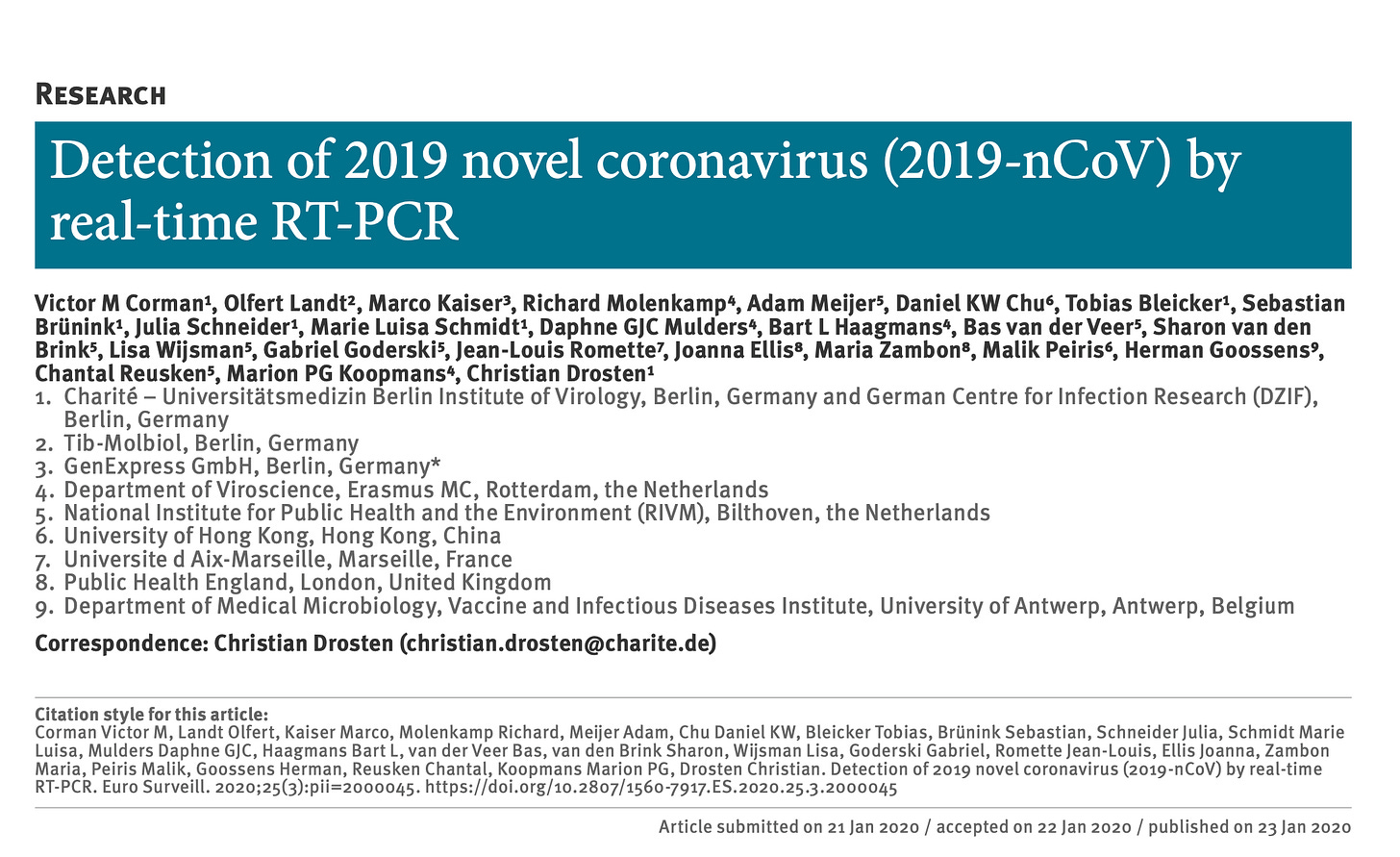
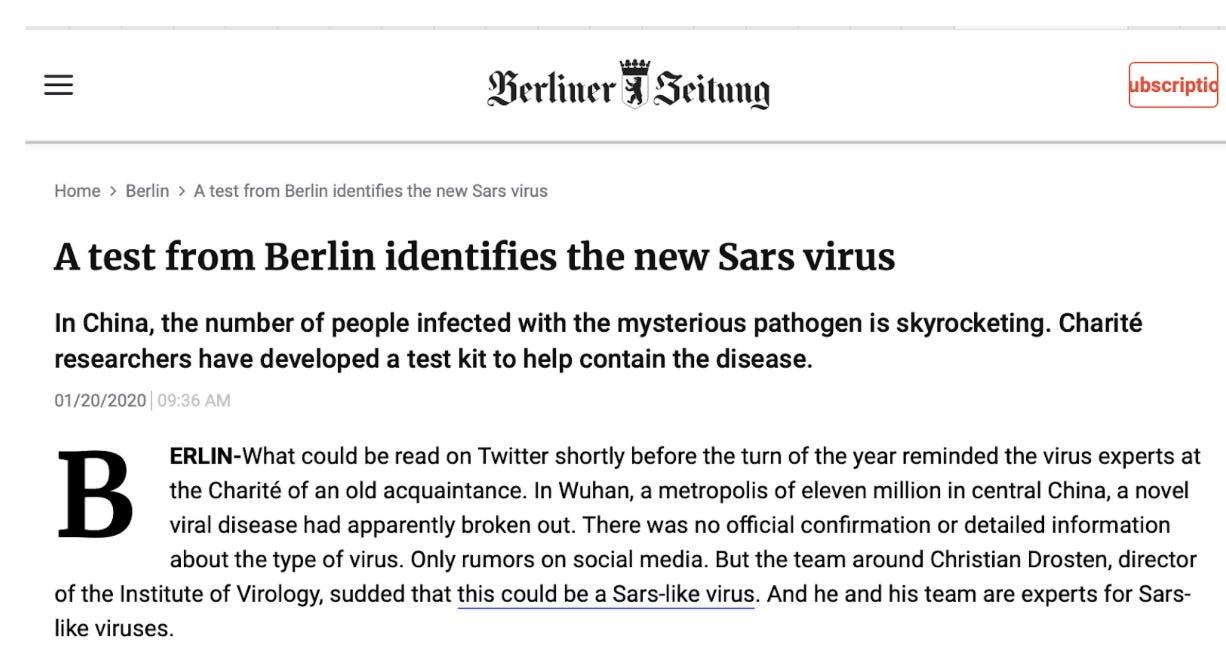
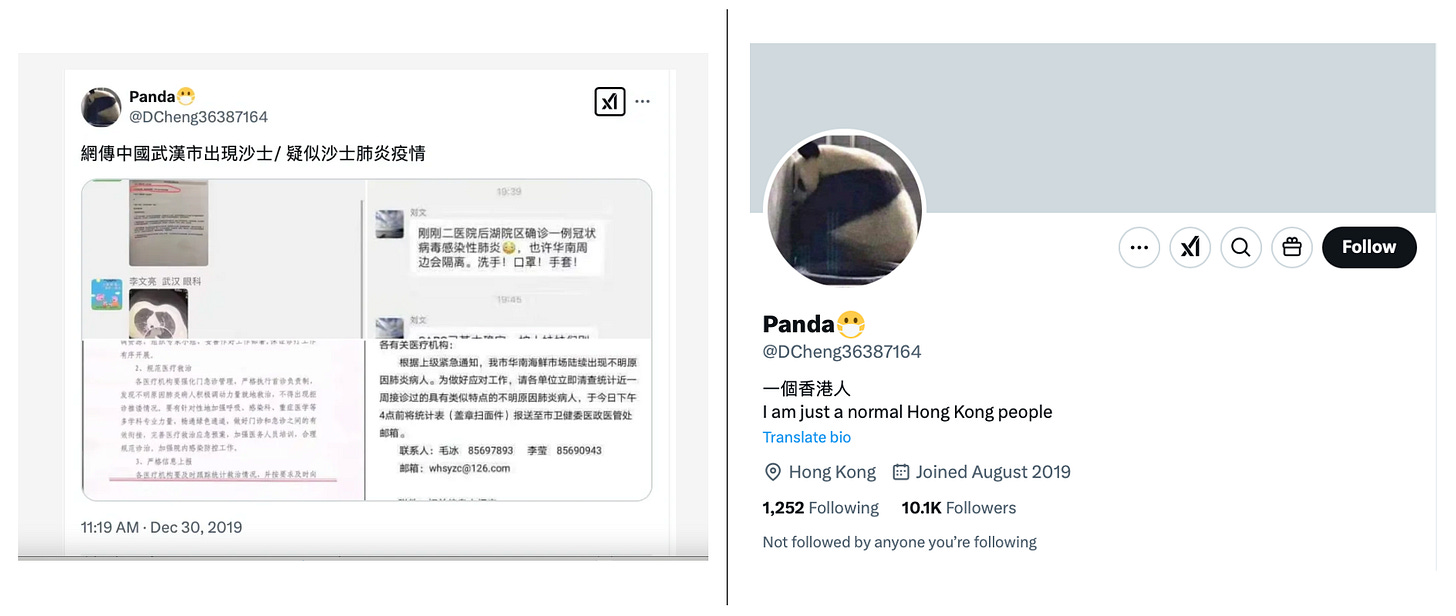
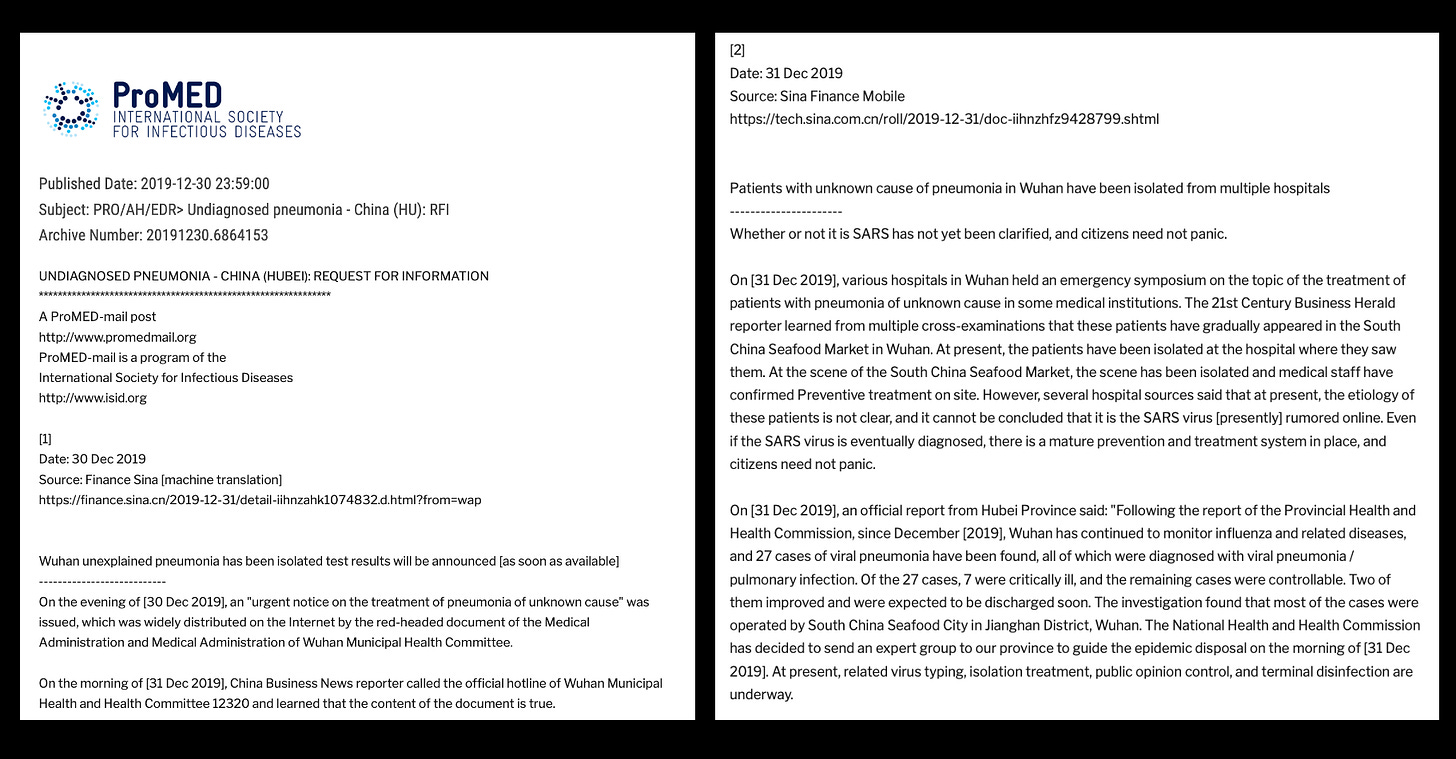
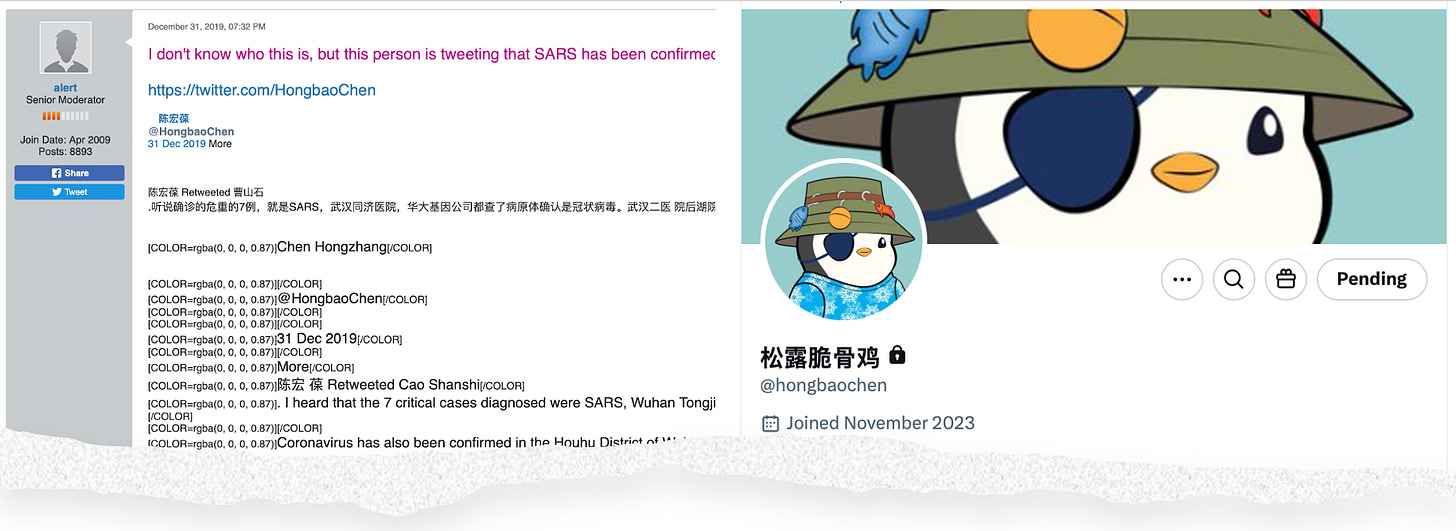

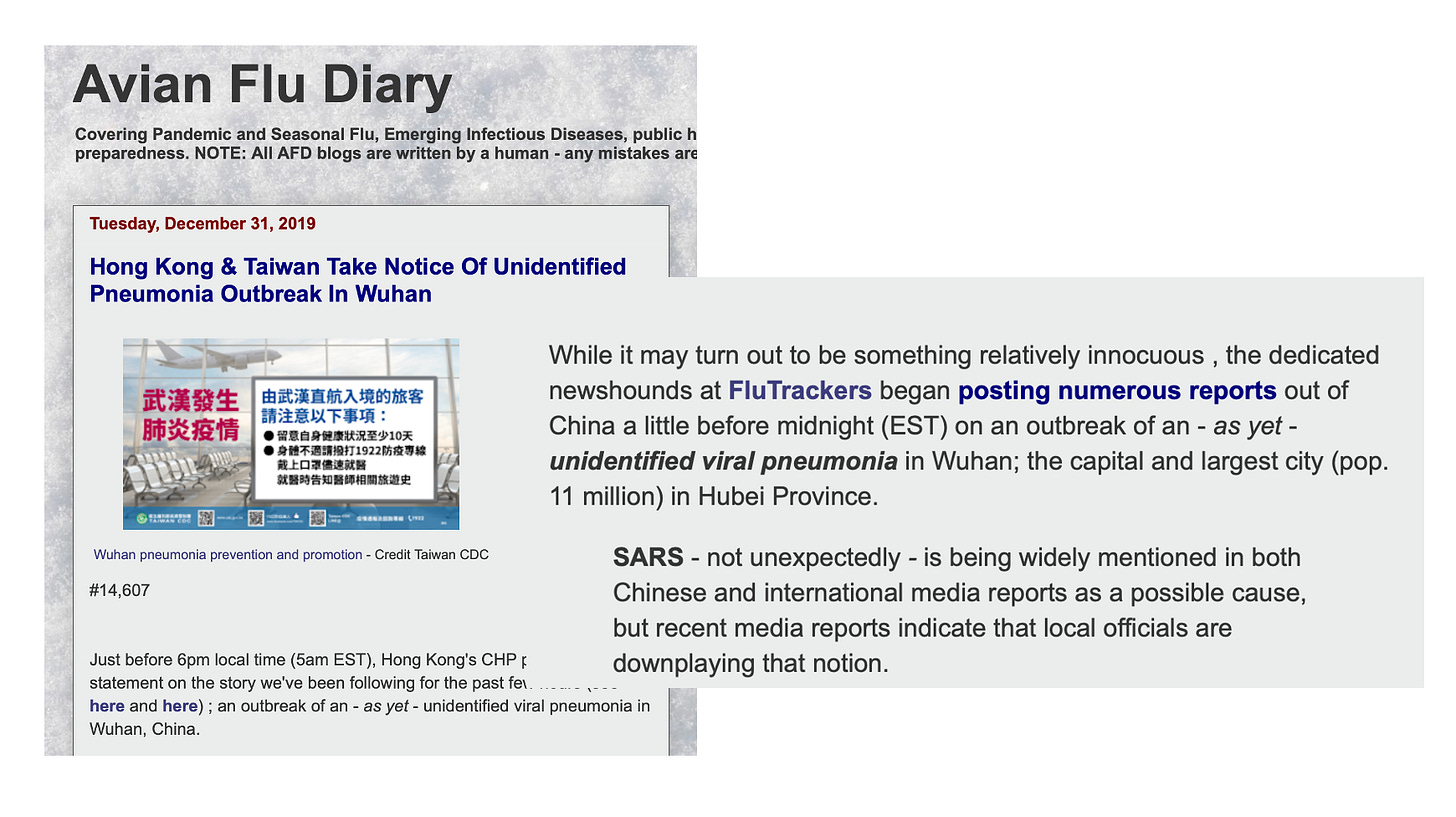
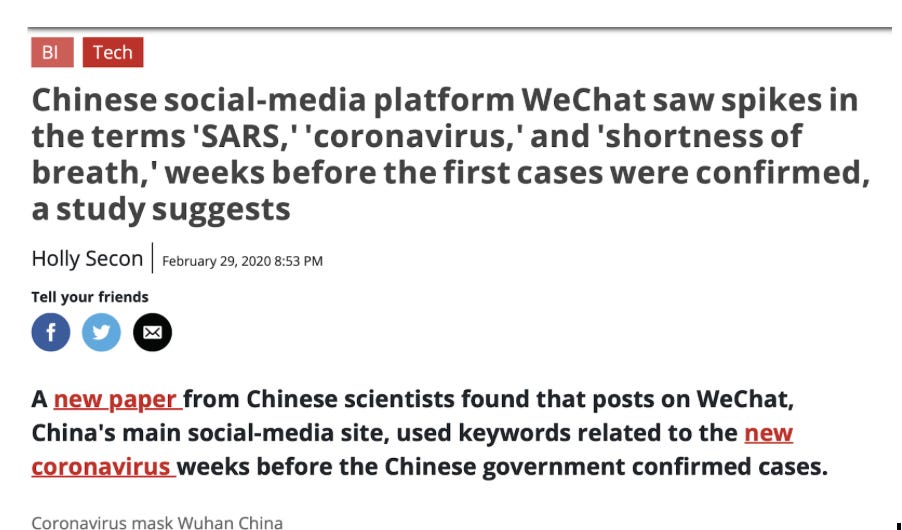
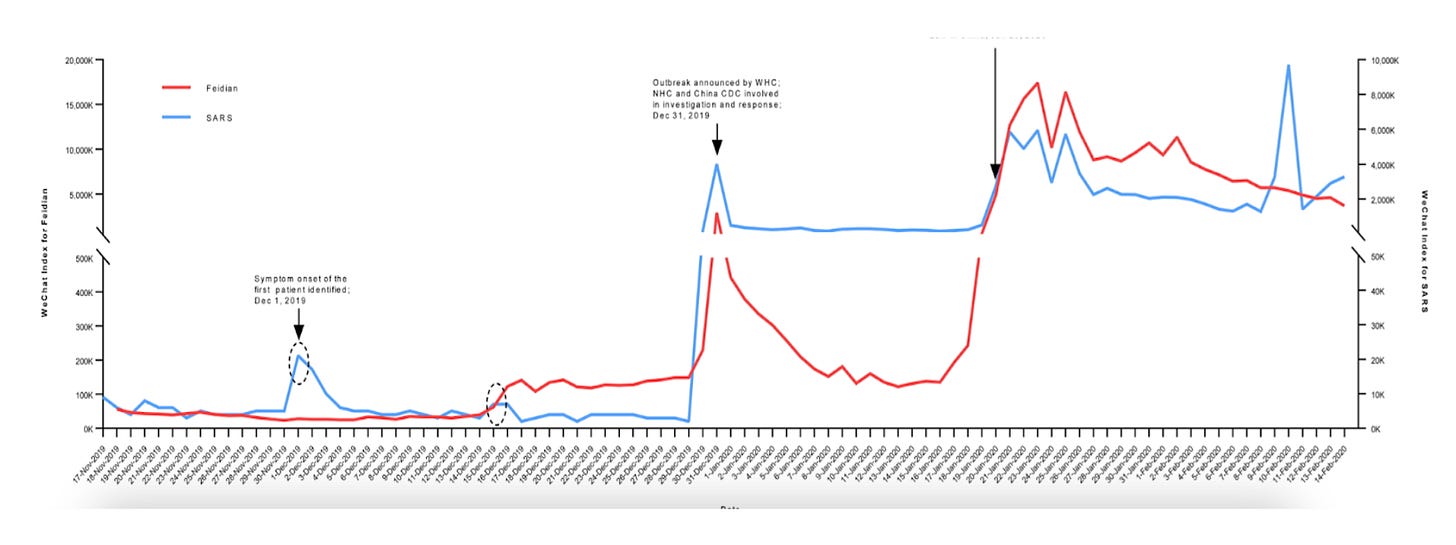
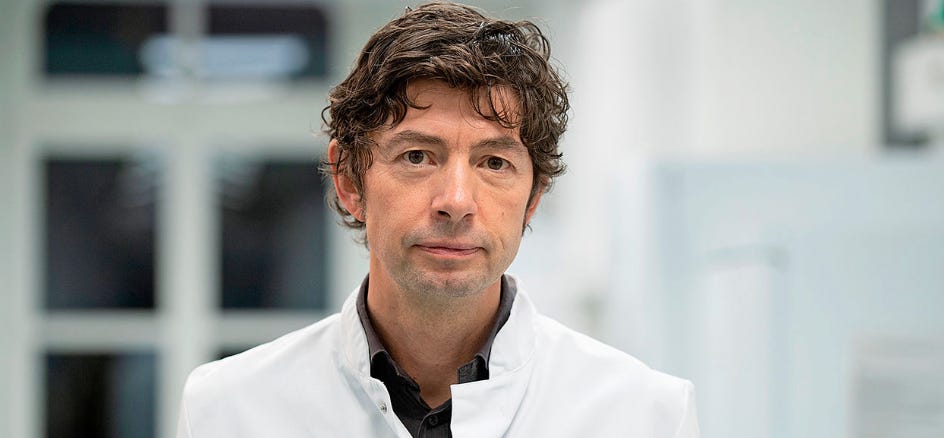

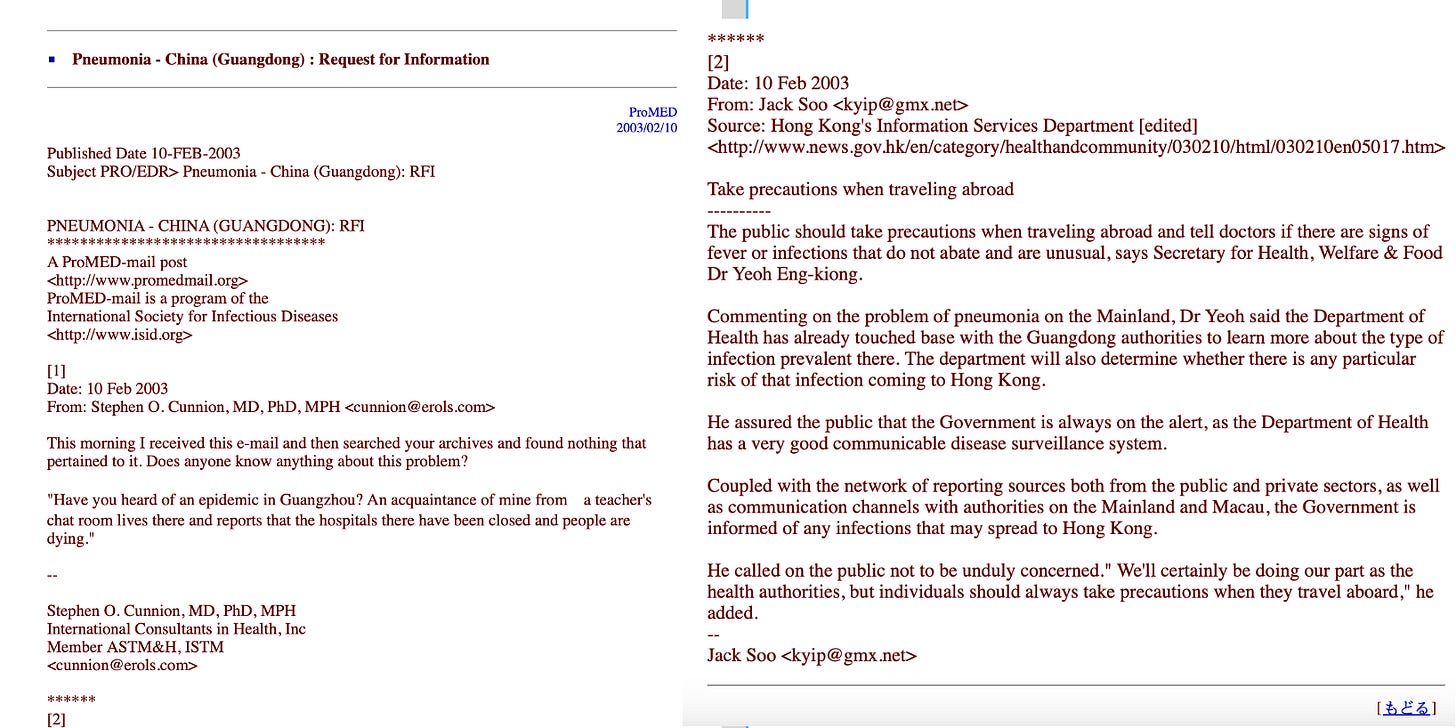
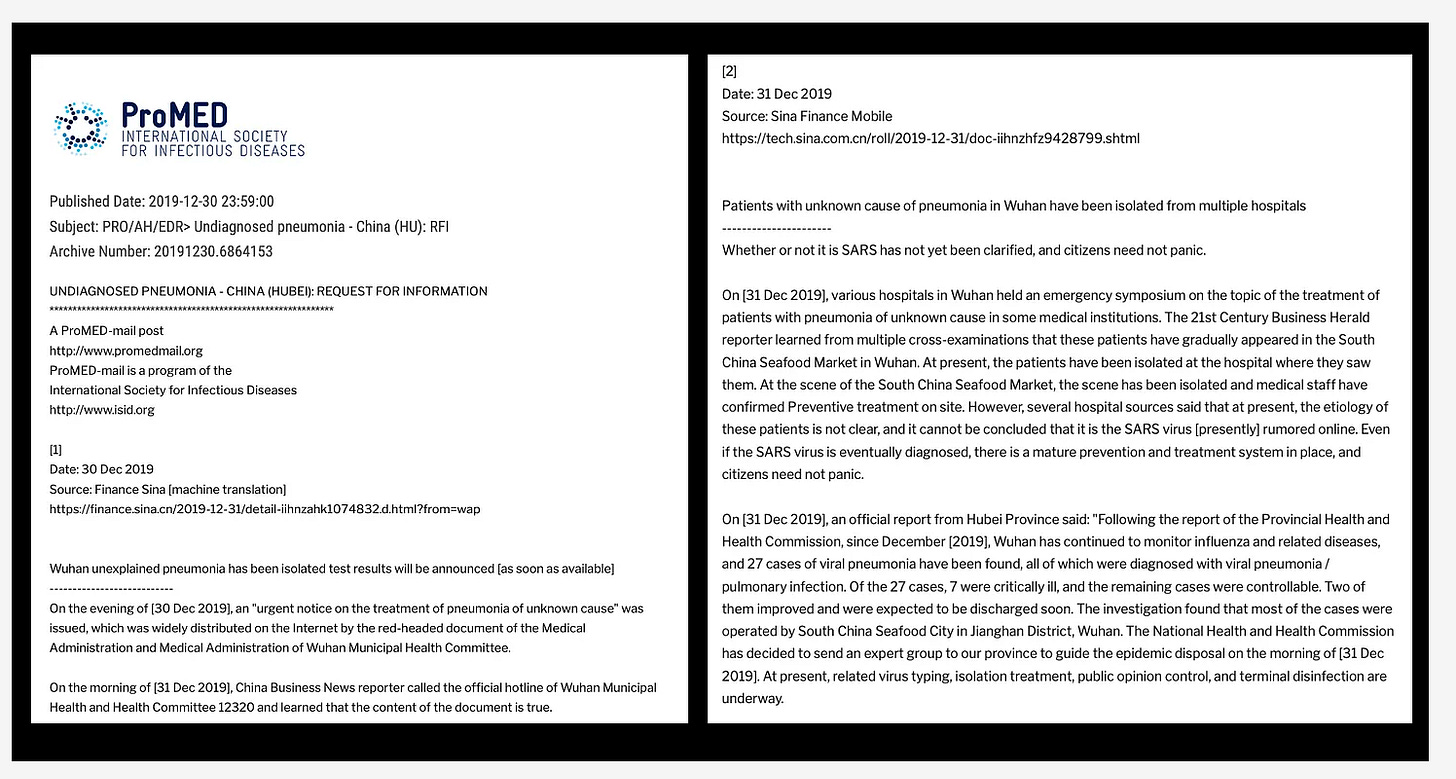



Adding on with individual comment:
In 2020, a group of experts submitted an external peer review of the Corman-Drosten paper to Eurosurveillance, analyzing the flaws RT-PCR test.
Unfortunately, their critique was rejected. https://www.researchgate.net/publication/346483715_External_peer_review_of_the_RTPCR_test_to_detect_SARS-CoV-2_reveals_10_major_scientific_flaws_at_the_molecular_and_methodological_level_consequences_for_false_positive_results
While the authors of the review focused on scientific flaws in the testing protocol, they did not address Corman et al.'s reliance on social media reports about a SARS-like virus being detected.
The review positioned itself as an evaluation of the paper, identifying the first "fatal flaw" as the test's reliance on theoretical sequences provided by a laboratory in China. I am not a PCR expert, but if one or more of the scientists on the Corman-Drosten paper really did rely on social media reports for their "seek & find" endeavour, it seems THAT is first fatal flaw. And if they didn't, they lied.
At a minimum, Corman et al. should be required to cite their sources and clarify their methodology regarding these reports.
IMHO the great unfinished business of this whole debacle - the gaping hole that was left open, is the PCR. The notion that PCR can be used to “diagnose” communicable disease should have been resoundingly, thoroughly obliterated. Vaccine mandates came along and (rightly) consumed all of the attention. PCR was left with its reputation unscathed. It deserves equal vilification billing alongside mandates and mRNA technology because it is the driving mechanism of the madness.